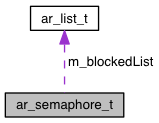Semaphores
 Collaboration diagram for Semaphores:
Collaboration diagram for Semaphores:Description
Semaphore API.
Classes | |
| struct | ar_semaphore_t |
| Counting semaphore. More... | |
| class | Ar::Semaphore |
| Counting semaphore class. More... | |
Semaphores | |
| ar_status_t | ar_semaphore_create (ar_semaphore_t *sem, const char *name, unsigned count) |
| Create a new semaphore. More... | |
| ar_status_t | ar_semaphore_delete (ar_semaphore_t *sem) |
| Delete a semaphore. More... | |
| ar_status_t | ar_semaphore_get (ar_semaphore_t *sem, uint32_t timeout) |
| Acquire the semaphore. More... | |
| ar_status_t | ar_semaphore_put (ar_semaphore_t *sem) |
| Release the semaphore. More... | |
| uint32_t | ar_semaphore_get_count (ar_semaphore_t *sem) |
| Returns the current semaphore count. More... | |
| const char * | ar_semaphore_get_name (ar_semaphore_t *sem) |
| Get the semaphore's name. More... | |
Class Documentation
◆ ar_semaphore_t
| struct ar_semaphore_t |
 Collaboration diagram for ar_semaphore_t:
Collaboration diagram for ar_semaphore_t:| Class Members | ||
|---|---|---|
| ar_list_t | m_blockedList | List of threads blocked on the semaphore. |
| volatile unsigned | m_count | Current semaphore count. Value of 0 means the semaphore is owned. |
| const char * | m_name | Name of the semaphore. |
Function Documentation
◆ ar_semaphore_create()
| ar_status_t ar_semaphore_create | ( | ar_semaphore_t * | sem, |
| const char * | name, | ||
| unsigned | count | ||
| ) |
Create a new semaphore.
- Parameters
-
sem Pointer to storage for the semaphore. name Pass a name for the semaphore. If NULL is passed the name will be set to an empty string. count The initial semaphore count. Setting this value to 0 will cause the first call to get() to block until put() is called. A value of 1 or greater will allow that many calls to get() to succeed.
- Return values
-
kArSuccess Semaphore initialised successfully.
◆ ar_semaphore_delete()
| ar_status_t ar_semaphore_delete | ( | ar_semaphore_t * | sem | ) |
Delete a semaphore.
Any threads on the blocked list will be unblocked immediately. Their return status from the get function will be kArObjectDeletedError.
- Parameters
-
sem Pointer to the semaphore.
- Return values
-
kArSuccess Semaphore deleted successfully.
◆ ar_semaphore_get()
| ar_status_t ar_semaphore_get | ( | ar_semaphore_t * | sem, |
| uint32_t | timeout | ||
| ) |
Acquire the semaphore.
The semaphore count is decremented. If the count is 0 upon entering this method then the caller thread is blocked until the count reaches 1. Threads are unblocked in the order in which they were blocked. Priority is not taken into consideration, so priority inversions are possible.
- Note
- This function may be called from interrupt context only if the timeout parameter is set to kArNoTimeout (or 0).
- Parameters
-
sem Pointer to the semaphore. timeout The maximum number of milliseconds that the caller is willing to wait in a blocked state before the semaphore can be obtained. If this value is 0, or kArNoTimeout, then this method will return immediately if the semaphore cannot be obtained. Setting the timeout to kArInfiniteTimeout will cause the thread to wait forever for a chance to get the semaphore.
- Return values
-
kArSuccess The semaphore was obtained without error. kArTimeoutError The specified amount of time has elapsed before the semaphore could be obtained. kArObjectDeletedError Another thread deleted the semaphore while the caller was blocked on it. kArNotFromInterruptError A non-zero timeout is not alllowed from the interrupt context.
◆ ar_semaphore_get_count()
| uint32_t ar_semaphore_get_count | ( | ar_semaphore_t * | sem | ) |
Returns the current semaphore count.
- Parameters
-
sem Pointer to the semaphore.
◆ ar_semaphore_get_name()
| const char* ar_semaphore_get_name | ( | ar_semaphore_t * | sem | ) |
Get the semaphore's name.
- Parameters
-
sem Pointer to the semaphore.
◆ ar_semaphore_put()
| ar_status_t ar_semaphore_put | ( | ar_semaphore_t * | sem | ) |
Release the semaphore.
The semaphore count is incremented.
- Parameters
-
sem Pointer to the semaphore.
- Note
- This call is safe from interrupt context.


